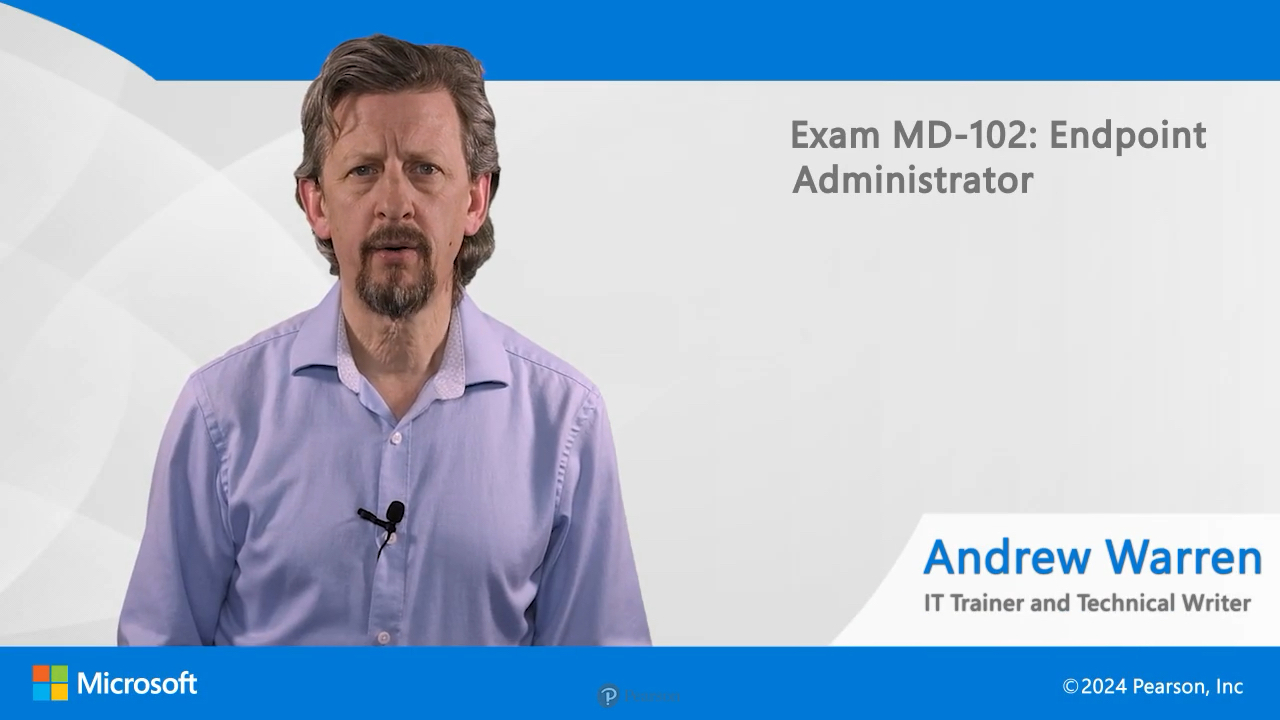Exam MD-102 Endpoint Administrator (Video)
- By Andrew Warren
- Published Jun 5, 2023 by Microsoft Press.
Online Video
- Your Price: $199.99
- List Price: $249.99
- About this video
Video accessible from your Account page after purchase.
Register your product to gain access to bonus material or receive a coupon.
Description
- Copyright 2023
- Edition: 1st
- Online Video
- ISBN-10: 0-13-827184-4
- ISBN-13: 978-0-13-827184-8
9+ Hours of Video Instruction
Prepare for the NEW MD-102 Endpoint Administrator exam and learn how to manage your organization's devices and client applications more effectively.
This self-paced instructional video course demonstrates how to deploy Windows clients, manage identity and compliance, maintain and protect devices, and manage applications. If you're planning to take Microsoft Exam MD-102 Endpoint Administrator, this video course covers the skills measured in a logical way to help you prepare for the exam and level-up in your career.
Throughout each lesson, Microsoft certified trainer and technical author Andrew Warren describes key concepts and puts them into action with demonstrations and real-world scenarios. Learn from an expert and gain the skills you need to achieve Microsoft 365 Certified: Endpoint Administrator Associate certification.
Learn How To:
- Deploy Windows client
- Manage identity and compliance
- Manage, maintain, and protect devices
- Manage applications
Who Should Take This Course:
- IT professionals who deploy, configure, protect, manage, and monitor devices and client applications in an enterprise environment
- Admins deploying endpoints at scale using Microsoft Intune, Windows 365, Windows Autopilot, Azure AD, and Microsoft Defender for Endpoint
- Endpoint administrators who want to work for efficiently and better collaborate with architects, security admins, and other enterprise stakeholders
- Candidates preparing for Microsoft Exam MD-102 Endpoint Administrator
Course Requirements:
- Experience with Azure AD and Microsoft 365
- Familiarity with Microsoft Intune
- Experience deploying, configuring, and maintaining Windows clients and non-Windows devices
About Pearson Video Training:
Pearson publishes expert-led video tutorials covering a wide selection of technology topics designed to teach you the skills you need to succeed. These professional and personal technology videos feature world-leading author instructors published by your trusted technology brands, including Microsoft Press. Learn more about Microsoft Press video at https://www.microsoftpressstore.com/video.
Sample Content
Table of Contents
Introduction
Module 1: Deploy Windows Client
Lesson 1: Prepare for a Windows Client Deployment
1.1 Assess readiness
1.2 Plan and select a deployment option
1.3 Upgrading to Windows 11
1.4 Plan for user state
Lesson 2: Plan and Implement a Windows Client Deployment by Using Windows Autopilot
2.1 Overview of Windows Autopilot
2.2 Create and assign deployment profiles
2.3 Extract and upload device hardware information
2.4 Deploy Windows 11
2.5 Troubleshoot deployment
Lesson 3: Plan and Implement a Windows Client Deployment by Using MDT
3.1 Choose configuration options
3.2 Create and manage images
3.3 Manage app and driver deployment
3.4 Create and use task sequences
3.5 Deploy images
3.6 Monitor and troubleshoot deployment
Lesson 4: Configure Remote Management
4.1 Implement remote management in Intune
4.2 Configure Remote Desktop
4.3 Implement PowerShell Remoting
4.4 Implement Windows Admin Center
Module 2: Manage Identity and Compliance
Lesson 5: Manage Identity
5.1 Compare identity providers
5.2 Implement user authentication
5.3 Implement devices in Azure AD
Lesson 6: Implement Compliance Policies
6.1 Plan device compliance policies
6.2 Implement compliance policies with conditional access
6.3 Manage compliance policies
Module 3: Manage, Maintain, and Protect Devices
Lesson 7: Manage the Device Lifecycle in Intune
7.1 Configure enrollment settings
7.2 Enroll devices in Intune
7.3 Review device inventory
7.4 Implement policy sets
Lesson 8: Manage Device Configuration with Intune
8.1 Plan device profiles
8.2 Implement device profiles
8.3 Manage device profiles
8.4 Implement kiosk mode
8.5 Implement Microsoft Tunnel
Lesson 9: Monitor Devices
9.1 Monitor device inventory reports with Intune
9.2 Monitor devices using Azure Monitor and Endpoint Analytics
Lesson 10: Manage Updates
10.1 Plan for Windows Updates
10.2 Deploy Windows updates
10.3 Monitor and troubleshoot updates
Lesson 11: Implement Endpoint Protection
11.1 Implement Microsoft Defender Credential Guard
11.2 Implement Microsoft Defender Exploit Guard
11.3 Implement Microsoft Defender Application Guard
11.4 Implement Microsoft Defender for Endpoint
11.5 Integrate Microsoft Defender Application Control
11.6 Manage Microsoft Defender Antivirus
11.7 Protect devices using Endpoint Security
11.8 Manage enterprise-level disk encryption
11.9 Implement security baselines in Intune
Module 4: Manage Applications
Lesson 12: Deploy and Update Apps
12.1 Deploy apps with Intune
12.2 Deploy apps with WCD
12.3 Plan and deploy Microsoft 365 Apps
Lesson 13: Implement App Configuration and App Protection
13.1 Plan and Implement App Protection policies
13.2 Plan and implement App Configuration policies
13.3 Secure data in Microsoft 365
Summary
More Information

